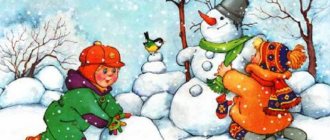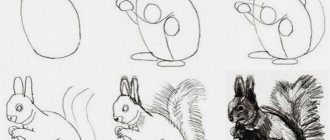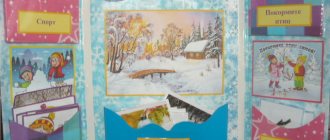Lesson summary “Zimushka - Winter”
Municipal state preschool educational institution “Kalacheevsky kindergarten No. 1 of general developmental type”
Festival of Pedagogical Ideas “Open Lesson”
Nomination: Lesson for preschoolers Lesson summary “Zimushka - Winter”
Children age 4 – 5 years
Belikova Vera Aleksandrovna, teacher, highest qualification. category
Topic: “Zimushka - winter” Age of children: 4 – 5 years (middle group) Integration of educational areas: “Speech development”, “Cognitive development”, “Artistic and aesthetic development” “Social and communicative development”, “Physical development”. Goal: To summarize and systematize children’s knowledge about the season - winter. Objectives: Educational: Clarify and consolidate knowledge about winter and its signs through the emotional perception of works of art. Developmental: Develop children's figurative speech, activate the vocabulary and enrich it with new words: blizzard, harsh, protracted, silver. Educational: To foster a love of nature and develop the aesthetic taste of children, to participate in the creation of collective work using non-traditional drawing techniques. Preliminary work: 1. Observation of winter phenomena in nature. 2. Examination of snow, snowflakes, frosty patterns on the windows. 3. Consideration of reproductions of paintings of winter landscapes: I. I. Shishkin “Forest in Winter”, A. Vasnetsov “Winter Dream”, I. Grabar “Winter Landscape”, “February Blue”. 4. Reading and memorizing poems about winter: Y. Akim “The First Snow”, S. Yesenin “Winter Sings and Haunts”, I. Surikov “Winter”, N. Nekrasova “It is not the wind that rages over the forest...”. 5. Listening to musical works: P.I. Tchaikovsky's cycle "The Seasons", A. Vivaldi's "Winter", F. Chopin's waltz "The Winter's Tale". Methods and techniques: Playful, visual, practical activities for children, questions for children, verbal, didactic games, use of fiction.
Materials and equipment: Demonstration material: window template (size A1), snowman sewn from lumps (height 100cm), chest for snowflakes; Handouts: sheets of paper measuring 15x15, with a wax pattern applied, paints, brushes, napkins, water jars, snowflakes - emoticons; ICT equipment: screen, projector, laptop; presentation on the theme “Winter's Tale”, soundtracks of musical works. GCD structure: I. Introductory part – 2 minutes a) psycho-gymnastics – mood; b) asking a riddle; II. Main part – 16 minutes a) conversation about weather phenomena in winter; b) physical education - self-massage; c) word game “Give me a word; d) physical education session; e) word game “Guess the riddle”; f) productive (visual) activities of children; g) viewing the presentation. III. Final part – 2 minutes a) teacher’s generalization; b) reflection. Progress of the activity: Educator: - Guys! Today we have an unusual meeting. Guests came to us. Let's say hello and share our warmth and kindness with them. We will all hold hands and smile at each other! The warmth from our hands will run around, around. The day will start with warmth, with warmth and kindness! – Place your hands on the heart and give all adults a piece of your warmth and kindness. - Well done. Our guests immediately felt warm and comfortable. - Come in and take your seats. – Now, listen to the riddle: “Troika, troika has arrived. The horses in that troika are white, And the queen sits in the sleigh - White-skinned, white-faced. As she waved her sleeve, everything was covered with snow.” - Guys, please tell me what queen is this riddle talking about? Children: About winter. Educator: - Dear guys, today we are visiting a fairy tale, but not a simple one, but a winter one. We are invited to our place by the beautiful, sparkling, sparkling beauty - Winter. Close your eyes and with the help of magical music we will find ourselves visiting Zimushka-Winter. 1, 2, 3, 4, 5 Everyone who wants to take a walk, Look around, turn around, You will find yourself in a winter fairy tale! (1 slide)
And here is the hostess of the winter fairy tale. (The teacher enters, dressed in winter, smart clothes). Winter sings 1st verse r. n. songs “Oh, you, Zimushka-winter”
– Hello, guys, I’m Zimushka – Winter. You are on the threshold of my winter fairy tale. But don't worry, I won't freeze you. After all, I'm not only cold. I can be different. – Do you guys know what I’m like, Winter? (Snowy, white, soft, light, fabulous, beautiful, blizzard, frosty, harsh, lingering, silver). - Well done! I want to hear what else you know about me? If you guess all my riddles and help me collect the snowman who wanted to meet you, but was in such a hurry that he rolled down the slide and fell apart, then I will be happy to invite you to my winter fairy tale. - Well, are you ready? – How can you know that winter has come? – What is your favorite holiday that we celebrate in winter? – What winter months do you know? - What month is it now? - Do you guys know that every month has its own proverb or saying: “December is the cap of winter”, “January is the beginning of the year, winter is the middle”, “February has two friends - a blizzard and a blizzard.” – Does the sun warm you in winter? – Are there leaves on the trees? – What do we see on the ground and in the trees? What kind of snow? – What are rivers covered with in winter? – Are the days long or short in winter? What about the nights? – Tell me, if it’s snowing outside, then the weather... Snow – (snowy) Frost – (frosty) Wind – (windy) Cold – (cold)
Well done! You know a lot about winter. Get your first snowball!
Educator: - Well, Zimushka - Winter, you froze us a little. Let's warm up, guys! Repeat after me! Winter has come, (three palms touching each other) Brought frost (we massage our shoulders and forearms with our fingers) Winter has come, (three palms touching each other) The nose is freezing (we massage the tip of the nose with our palm) Snow, (smooth movements with our palms) Snowdrifts, (fists knock on knees alternately) Ice (palms move on knees in different directions) Everyone outside - forward! (walking) We’ll put on warm pants, (we run our palms over our legs) A hat, a fur coat, felt boots (we run our palms over our heads, our hands, we stamp our feet) We warm our hands in mittens (circular movements with the palms of one hand around the other palm) And we tie scarves (we put our palms on on top of each other to the base of the neck)
Winter: - Warm up! Here's your next task:
Word game “Give me a word.” In a clearing, on a meadow (a snowball) is quietly falling, like white fluffs are falling from the sky... (snowflakes) There is a lot of work for shovels, more and more... (snowfall) Everyone is running in a race, everyone wants to play... (snowballs) As if dressed up in a white down jacket... (snowman ) Nearby there is a snow figure, it’s a girl... (Snow Maiden) As if in a fairy tale, as in a dream, the whole earth was decorated (snow) Well done! Did a good job. Get the second snowball. Educator: - Guys, do you like winter? Why? (children's answers) - Tell me, Zimushka - Zima, how do you play? Physical education lesson One, two, three, four, five We went for a walk in the yard: We made a snow woman, We fed the birds crumbs, We also rolled down the hill, And then we rolled around in the snow, We all came home in the snow, ate soup and went to bed.
Winter: - Yes, I see you have fun in winter. Now guess the riddles about my assistants: Who sings snow songs all night long? The wind is a winter friend, Will blow snowdrifts... (blizzard)
They curl around the ground like a snake, They howl pitifully in the chimney, They cover the spruce trees with snow. These are winter... (blizzards)
Sweeps the paths in the park, Collects snow into snowdrifts. Who is this stranger, have you guessed? (Snow drift)
On a winter day, very slippery glass lay on the pond. The strong, smooth blue one invites us to play hockey... (ice)
Our windows are like pictures. Who is the invisible artist? Whose patterns? - Here's a question. I drew them... (frost)
Educator: – Frost is the main winter artist – invisible. What beautiful patterns he draws on the windows. Do you want to learn how to draw winter patterns? Come to the workshop, I will teach you. Each of you has a small “glass”, take blue paint and carefully paint it over. - What's happening? Wonderful frosty patterns appear! You are real wizards! (Children paint over the “leaves - pieces of glass” in blue, where the pattern was previously drawn with a candle or wax crayons). – What amazing patterns you made. Well done! Let's create a frosty pattern on our winter window. (Children lay out their drawings on the window template). - Get another snowball. So the snowman is ready! Winter: - Well done, guys! You did an excellent job with my tasks, assembled a snowman, so I am pleased to invite you to my winter fairy tale. View the presentation: winter landscapes with musical accompaniment. Educator: - Well, guys, we went on a wonderful journey, met the owner of the winter fairy tale and her little helper. Let's thank them and say goodbye until next time.
Reflection. Educator: - Did you like the winter fairy tale? – What did you like most? – Do you still want to visit a winter fairy tale? – What is your mood now? – Take a snowflake - the mood and put it in our winter chest. Let's save these snowflakes until our next meeting with a winter fairy tale.
Methodological recommendations: 1. This lesson can be held as an open event for teachers and parents. 2. The material can be used when compiling musical and literary leisure activities on the lexical topic “Winter. Winter fun." 3. We recommend using some elements of the lesson (psycho-gymnastics, physical education with elements of self-massage) in various types of children's activities. 4. We recommend using non-traditional drawing techniques in art classes.
Literature: 1.Educational program of preschool educational institution: FROM BIRTH TO SCHOOL. Approximate general educational program for preschool education / Ed. N. E. Veraksy, T. S. Komarova, M. A. Vasilyeva. - M.: MOSAIC SYNTHESIS, 2021. - 368 p. 2. Vladimirskaya L.A. From autumn to summer. Children about nature and the seasons in poems, riddles, proverbs, stories about Orthodox holidays. - IZD - VO.: UCHITEL, 2014. 3. Leonova N. N. “Artistic and aesthetic development of children in the middle group of preschool educational institutions.” Long-term planning, notes. St. Petersburg CHILDHOOD – PRESS, 2014.






